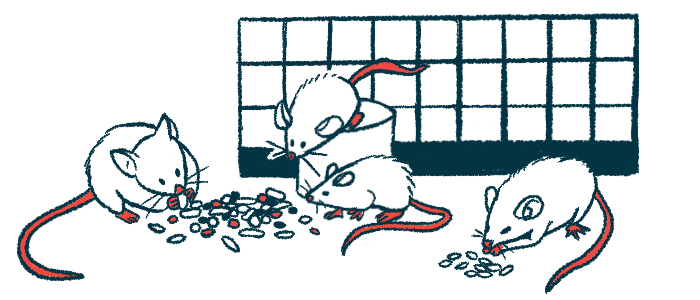Adding miglustat to Lumizyme or Nexviazyme no help to mice
Miglustat did not boost effects of the Pompe enzyme replacement therapies
Written by |

Adding the enzyme stabilizer miglustat did not improve the effectiveness of Lumizyme (alglucosidase alfa) or Nexviazyme (avalglucosidase alfa) in a mouse model of Pompe disease, a new study reports.
“These data demonstrate that co-administration of miglustat with either [Lumizyme or Nexviazyme] to Pompe mice provides no additional benefit,” the researchers wrote.
The study, “Increasing enzyme mannose-6-phosphate levels but not miglustat co-administration enhances the efficacy of enzyme replacement therapy in Pompe mice,” was published in the Journal of Pharmacology and Experimental Therapeutics. The work was funded by Sanofi, which markets both Lumizyme and Nexviazyme.
Pompe disease is caused by mutations that disrupt the function or production of the enzyme acid alpha-glucosidase (GAA). This enzyme is needed to break down a complex sugar molecule called glycogen. Without a working version of GAA, glycogen builds up to toxic levels in cells, especially muscle cells.
Lumizyme and Nexviazyme are enzyme replacement therapies designed to administer a working version of the GAA enzyme into the body, helping to clear toxic glycogen.
Lumizyme, sold as Myozyme outside the U.S., was the first enzyme replacement therapy to be widely approved for Pompe disease. Nexviazyme contains a version of the GAA enzyme that’s modified so that it’s better at getting into muscle cells.
Two-part therapy
Miglustat is a small molecule that can bind to the GAA enzyme and stabilize it. This small molecule is half of the two-part therapy that’s long been known as AT-GAA, which was approved recently to treat adults with late-onset Pompe disease (LOPD) in the European Union and the U.K.
The two-part therapy combines miglustat, sold as Opfolda, with a novel enzyme replacement therapy called cipaglucosidase alfa, sold as Pombiliti. It was developed by Amicus Therapeutics.
Miglustat has not been studied in combination with other enzyme replacement treatments. In this study, scientists conducted a series of tests to evaluate whether adding miglustat might increase the functionality of Lumizyme or Nexviazyme.
In line with other data, results showed that miglustat did stabilize Lumizyme or Nexviazyme. But, even though the enzymes were more stable with miglustat, the small molecule actually decreased enzyme activity.
“Interestingly, while both [Lumizyme or Nexviazyme] were stabilized in the presence of [miglustat], the addition of miglustat resulted in a significant reduction of GAA activity overall,” the researchers wrote.
The scientists speculated this might be because when miglustat binds to these enzyme replacement therapies, it can block the part of the GAA enzyme that’s needed to break down glycogen. So, the enzyme can’t work as well even though it’s more stable.
In a mouse model of Pompe disease, adding miglustat to treatment with Lumizyme or Nexviazyme did not significantly alter the pharmacological properties of either medication, and it did not increase the treatments’ ability to clear glycogen from muscle tissue.
No substantial reduction in glycogen clearance
Although adding miglustat reduced the functionality of Lumizyme and Nexviazyme in lab tests, adding miglustat did not substantially reduce glycogen clearance in the mouse models.
The researchers showed that, in this mouse model, the mice’s muscle cells had notable changes in gene expression (which genes are turned on or off). Treatment with enzyme replacements reversed many of these changes, with more profound effects seen with Nexviazyme compared to Lumizyme, but these effects were not improved by adding miglustat.
Overall, these data suggest that adding miglustat to Lumizyme or Nexviazyme offers no treatment benefit, the researchers said.






